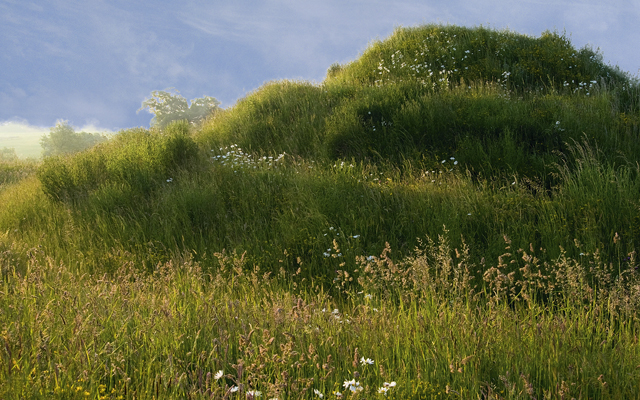How to create a mound in the garden
Alan Titchmarsh on the joys of having a mound in his garden.


Of all the features in my garden, the one that gives my family the most pleasure is the simplest of them all: it’s a mound of earth. Well, to give it its historically accurate name, it’s a ‘mount’, but the lesser title is the one invariably bestowed upon it in our household.
For its existence, I blame my wife and the landscape designer Kim Wilkie. We were invited to Kim’s for lunch some years ago and he walked us around his garden, then into the meadow that runs away from it. There, in a corner, stood a small grassy hillock, which supported a spiralling, mown pathway. Slowly, we ambled up the gentle helix and, after a few seconds, reached the top, where a surprising view of the Hampshire countryside opened up before us.
My wife was smitten with the idea and so I found myself locating a spot on rising ground in a corner of our wildflower meadow in which to create a verdant dome, after the fashion of those so beloved by 17th- and 18th-century landowners. They were a place from which they could espy the estate, look over the adjacent river or ensure that the staff in their demesnes were working and not idling.
Before work could begin, I had — somewhat to my surprise — to apply for planning permission. It was granted and work began to raise up the profile of a circle approximately 30ft in diameter. We began by using hard core — rubble, pounded into place. Then came rough topsoil, in the hope that it would be less likely to sink than richly organic material.
We sculpted our gentle spiral as we went, creating a small hill perhaps 12ft high. Finally, we added topsoil of about 1ft in depth, firmed it into place and sowed the grass seed.
Soon, the muddy hillock developed a green haze and, five years on, it is a fully-fledged mount. Has it changed? Well, it has shrunk a little. However hard the earth is firmed on such a construction, settlement takes place and our mount is now about 10ft high. But what is surprising, when you circle around the mown path to the top, is how greatly the view of the surrounding countryside is improved as you rise up and how much further you can see as a result of the elevation. It also tends to be a little windier up there.
We cut the path up to the top with a rotary mower once a week and the sloping sides are trimmed monthly with a hover mower, attached to a rope and swung from side to side. It’s a job for a virile youth; those of us of more mature years find it easier to use a strimmer.
Exquisite houses, the beauty of Nature, and how to get the most from your life, straight to your inbox.
Problems? Not many. The south side tends to become a little more scorched than the north in really hot weather and, in winter, a badger will dig around a little for vole nests, but the activity stops come the spring, when any holes are filled with topsoil and any scars are re-seeded.
The joys, however, are endless. We sit atop our mound and share a bottle of wine on warm, fine days, before heading indoors for supper. And the grandchildren — all under the age of four at the moment — shriek with delight as they slide down its sides on their bottoms.
No elaborate playhouse could offer them more fun and my wife and myself greater delight. And the grandchildren have their own name for it. ‘Can we go up the mountain?’ they ask, each time they visit us. It is impossible to disappoint them. And modern washing machines make the laundering of small pairs of jeans so much easier.
What spires to plant in the garden
Tom Coward suggests lofty spires to inspire.

Chelsea Flower Show 2015: New plants to see
Keep your eyes peeled for these new introductions.
Country Life is unlike any other magazine: the only glossy weekly on the newsstand and the only magazine that has been guest-edited by His Majesty The King not once, but twice. It is a celebration of modern rural life and all its diverse joys and pleasures — that was first published in Queen Victoria's Diamond Jubilee year. Our eclectic mixture of witty and informative content — from the most up-to-date property news and commentary and a coveted glimpse inside some of the UK's best houses and gardens, to gardening, the arts and interior design, written by experts in their field — still cannot be found in print or online, anywhere else.
